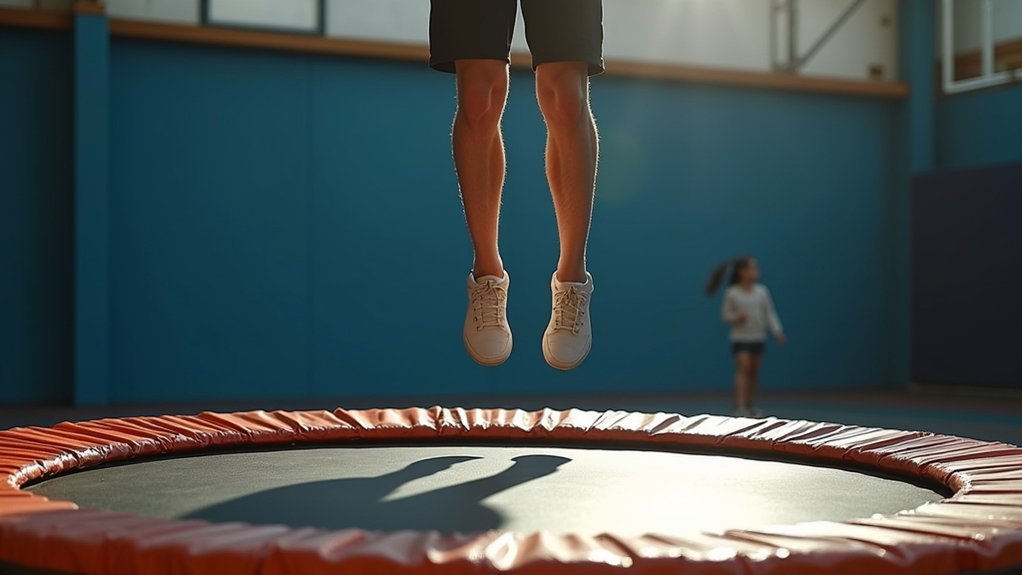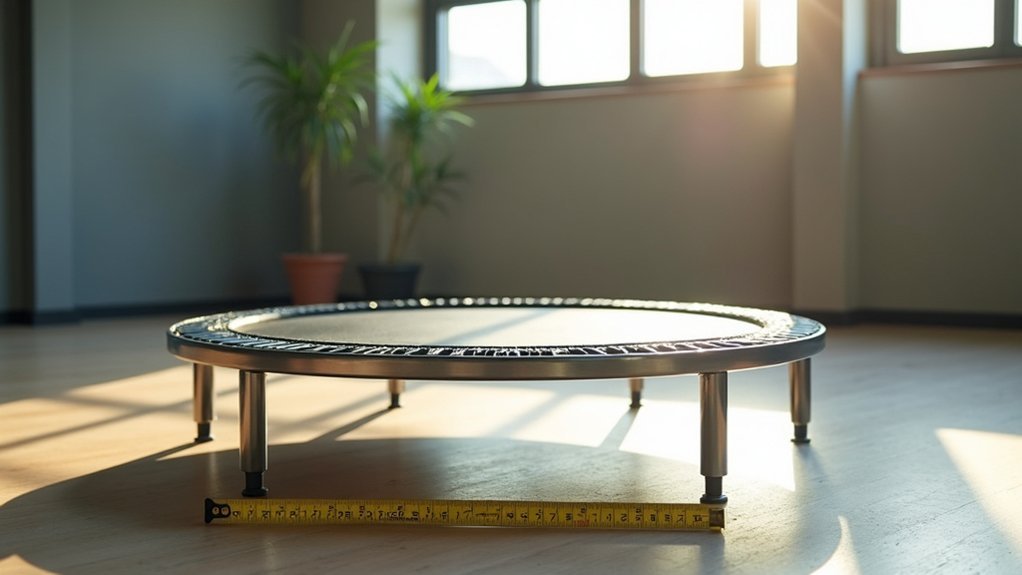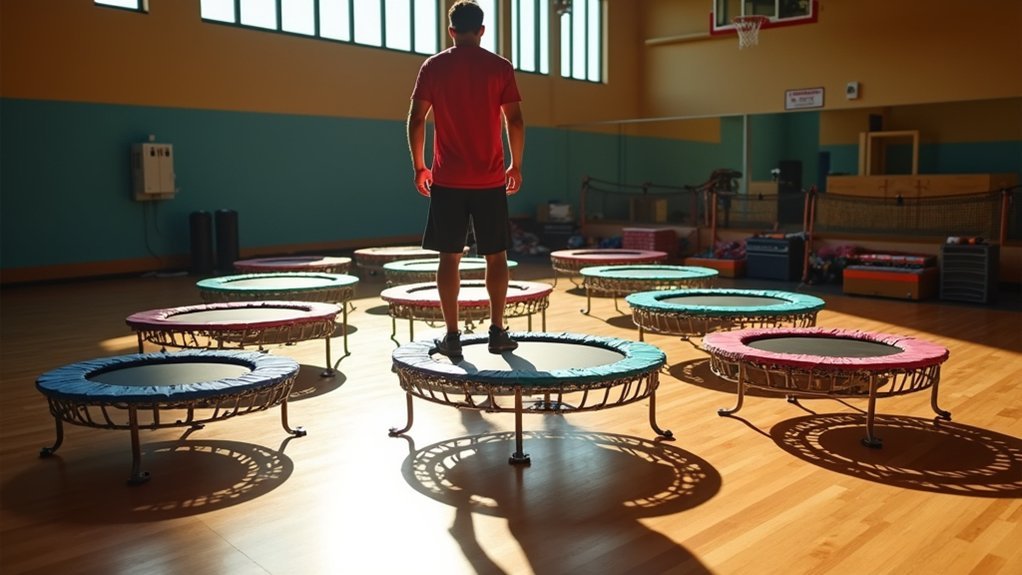For rebounder success when you’re 6’0″ or taller, look for models with at least 44″ diameter, 300+ pound weight capacity, and powder-coated steel frames. Choose bungee cord systems over springs for better joint protection, and make sure handlebars extend to at least 42″ with multiple height settings. Opt for folding designs with 30-ply mesh and adjustable tension to accommodate your longer stride. The right equipment transforms bouncing from an awkward struggle into an effective workout.
Why Standard Rebounders Often Fall Short for Tall Users

While many exercise enthusiasts embrace rebounding for its low-impact benefits, tall individuals quickly discover that standard models present unique challenges. At 32-39 inches, conventional rebounders simply don’t provide enough surface area for your full range of movement, increasing your risk of missteps near the edges during dynamic routines.
You’ll find that generic bungee tensions lack adjustability for your longer limbs and heavier frame, creating inefficient rebound patterns that compromise your exercise effectiveness. The 44″ trampolines offer significantly more room for complex movements that tall users require for effective workouts.
Standard stabilizer bars rarely reach the 54″+ height you need for proper grip, while inadequate leg designs create unstable foundations for your higher center of gravity.
The cramped surface forces unnatural posture adjustments, restricting knee flexion and overhead movements while accelerating equipment wear through increased leverage forces your height generates.
Essential Height and Diameter Measurements for 6’+ Exercisers
Because your height greatly impacts your rebounding experience, selecting the right dimensions becomes crucial for both safety and effectiveness. If you’re over 6 feet tall, standard 39″ rebounders simply won’t provide adequate surface area for proper foot placement during lateral movements. Regardless of the size you choose, prioritizing quality construction will ensure your rebounding experience remains safe and effective in the long term.
| Height Range | Recommended Diameter | Primary Benefit | Weight Capacity | Tension System |
|---|---|---|---|---|
| 6’0″ – 6’2″ | 44″ minimum | Stride coverage | 220+ lbs | Medium-firm |
| 6’2″ – 6’4″ | 44″-47″ | Stability | 250+ lbs | High-tension |
| 6’4″ – 6’6″ | 47″ or larger | Joint protection | 275+ lbs | Reinforced |
| 6’6″ – 6’8″ | Custom sized | Proper mechanics | 300+ lbs | Heavy-duty |
| 6’8″+ | 50″+ commercial | Fall prevention | 350+ lbs | Professional |
Always calculate your needed mat surface by subtracting 12-13″ from the frame diameter to guarantee sufficient rebounding area.
Weight Capacity and Frame Durability Requirements

Since tall individuals typically have larger frames and greater body mass, your rebounder must accommodate both your static weight and the dynamic forces generated during exercise.
Look for models with minimum 300-pound capacities, though 440-500 pound thresholds provide greater safety margins.
Prioritize powder-coated steel frames over aluminum alternatives—they withstand repeated impact better.
Your rebounder should weigh at least 20 pounds to prevent unwanted movement during vigorous workouts.
Continuous circumferential welding at joints guarantees structural integrity.
Bungee suspension systems offer superior impact absorption compared to springs, reducing strain on your joints.
For maximum stability, choose models with 47″ diameters, 16″ ground clearance, and six or more rubber-tipped legs.
Premium models like the Bellicon and JumpSport offer excellent options for taller users with their high-quality materials and superior weight capacities.
Remember that regular inspection of welds and connectors prolongs your rebounder’s lifespan, especially under heavier loads.
Tension Systems That Support Longer Limbs
Properly matching tension systems to your height can transform a jarring rebound experience into a fluid workout that accommodates longer limbs.
You’ll want to seek rebounders with progressive tension adjustment that provides higher rebound coefficients, creating more responsive support as your weight distributes across the mat. For taller individuals, adjustable tension settings are essential since height often correlates with different weight distribution patterns compared to shorter users.
Extended arc support systems specifically benefit taller users by ensuring the entire bounce trajectory remains comfortable, even when your limbs extend further during exercises.
Progressive Tension Adjustment
Taller rebounders require tension systems that can effectively manage their longer limbs and increased leverage. As a tall person, you’ll need to gradually adapt your rebounder’s resistance level as your skills advance.
- Choose rebounders with modular tension components that allow you to incrementally increase stiffness as your strength and endurance improve.
- Look for bungee-cord systems over traditional springs, as they provide smoother resistance curves for controlled deceleration—critical for protecting your joints.
- Test tension settings before each workout to verify the resistance matches your current fitness level and exercise goals.
- Consider models with interchangeable cord lengths that let you customize rebound depth without compromising proper form.
The adjustable tension EnduroLast™ Elastic Cords provide optimal customization for taller users who need personalized resistance to accommodate their unique biomechanics.
Remember to monitor tension degradation regularly, as your height and weight create greater force loads on the equipment.
Higher Rebound Coefficients
When your limbs extend further from your center of gravity, you’ll need tension systems specifically designed to accommodate this increased leverage. As a tall person, look for rebounders with customizable tension that can be adjusted to your weight and limb length.
Elastic cord systems provide quieter, smoother rebounds that give you more controlled movement—essential when your longer limbs create additional momentum. These systems are particularly beneficial as they reduce impact on joints compared to exercising on hard surfaces. Higher tension settings enhance mechanical efficiency for your extended reach, allowing for more effective workouts while reducing strain on your joints.
Your height demands more from a rebounder’s surface response. The right tension system will transform your workout experience, converting what could be awkward bouncing into fluid, supportive movement.
This adaptability guarantees you’ll get peak performance regardless of your exercise intensity or fitness level.
Extended Arc Support
Extended Arc Support requires special attention for those with longer limbs, as your body’s mechanics create unique leverage forces during rebounding. Look for rebounders engineered with tension systems that accommodate your full extension and powerful throws.
- 30-ply mesh netting with 28 bungee hooks allows you to customize tension based on your height and throwing force
- 72″ height profile matches your natural stance, with multi-zone rebound surfaces that simulate varied trajectories for your extended reach
- 1.25″ powder-coated steel frames with ground spikes prevent tipping during high-intensity drills involving your full body engagement
- Curved profiles reduce unnatural joint angles during full-extension movements, while the wide arc distributes force across a greater surface area for angled rebounds
The silver powder-coated finish on the frame enhances durability while maintaining a professional appearance during outdoor training sessions.
Stability Features That Prevent Tipping During High Bounces
For tall individuals who enjoy vigorous rebounding sessions, stability becomes a vital concern as your center of gravity sits higher than average users.
Look for rebounders with wide, heavy bases that provide a solid foundation against tipping. Choose models with high weight capacities and frames specifically designed to handle dynamic movement.
The arrangement of springs or cords greatly impacts stability—opt for rebounders with adjustable tension that lets you customize firmness based on your height and workout intensity. The adjustable handles provide additional stability during your workout by offering a secure grip at your ideal height.
Consider rebounders with stability bars for additional balance support during ambitious jumps. Larger jumping surfaces give you more room to maintain your center of balance, while non-slip floor supports prevent the entire unit from sliding.
Remember that proper weight distribution across the frame is essential—models with evenly distributed support points offer better stability during those higher bounces.
Ergonomic Handlebar Positioning for Taller Frames

As stability guarantees your safety during bounces, proper handlebar height becomes equally important to your rebounding experience.
When you’re tall, standard handlebar heights often force uncomfortable hunching that compromises your form and increases injury risk.
Look for rebounders offering:
- At least 10 height settings with maximum extension exceeding 42″ to accommodate your longer torso
- Dual-layer foam grips with 30-35mm diameter options for larger hands
- Adjustability that maintains parallel forearm alignment relative to your torso
- Clear increment markings to help you fine-tune positioning for your specific limb proportions
Remember that proper handlebar positioning prevents wrist strain and enables correct core engagement. Maximus rebounders feature stability bars that move with your bounce, providing additional support for taller individuals.
Proper handlebar alignment is essential for protecting your wrists while maximizing core muscle activation during rebounding exercises.
The Maximus Pro bar supports users up to 330lbs with weighted base compatibility—ideal if you’re both tall and athletic.
Space-Efficient Storage Solutions Without Sacrificing Size
Tall individuals shouldn’t have to compromise on rebounder mat size even when space is limited. Instead, look for models with folding frames that collapse down for easy storage while still offering a generous mat surface when assembled.
Choose rebounders with three-piece frames that you can disassemble completely or ones with removable legs for flexible storage options. Consider JumpSport’s 44″ frame, which provides ample bounce space for taller users but remains compact enough for smaller homes. The Fit Bounce Pro XL features a convenient half folding design that makes storage easy while still providing a large 86cm jumping surface ideal for taller users.
Utilize vertical storage by hanging your rebounder on wall hooks when not in use, or slide folded models under beds or behind doors.
For maximum space efficiency, select rebounders with optional accessories that store separately and detachable handlebars you can remove without compromising the stability you need at your height.
Frequently Asked Questions
Can Rebounders Help With Back Pain Specific to Tall People?
Yes, rebounders help with your back pain by reducing spinal compression, strengthening core muscles, and improving posture—all especially beneficial for your taller frame that experiences greater gravitational stress on vertebrae.
How Do Different Bounce Surfaces Affect Joint Impact for Taller Users?
As a taller person, you’ll find bungee rebounders provide gentler, more distributed force on your joints. They absorb impact better than spring models, which offer firmer bounces that may stress your knees and ankles more.
Are There Rebounders With Adjustable Leg Heights for Various Ceiling Clearances?
Most standard rebounders don’t have adjustable leg heights. Instead, look for foldable models for storage in low-ceiling areas. Focus on rebounders with tension adjustment rather than height-adjustable legs for your workout customization.
Do Folding Rebounders Compromise Stability for Users Over 6 Feet Tall?
Quality folding rebounders don’t compromise stability for users over 6 feet tall. Look for sturdy steel frames, high weight capacity, and larger mat surfaces. You’ll find many foldable options that remain secure during use.
How Often Should Tall Users Replace Springs or Bungees for Optimal Performance?
You’ll need to replace your rebounder’s springs or bungees every 2-3 years if you’re tall (6’+ and/or 200+ lbs). Check monthly for reduced bounce, sagging, or unusual noises to maintain peak performance.
In Summary
Don’t settle for a rebounder that compromises your workout or safety. As a tall person, you’ll need to prioritize diameter, weight capacity, and proper tension systems that accommodate your frame. Remember to check handlebar height and stability features before purchasing. With the right equipment, you’ll enjoy all the benefits of rebounding without the discomfort or limitations of standard-sized models.





Leave a Reply